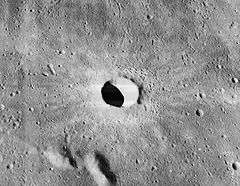Mösting (crater)
Mösting is a small lunar impact crater that is located in the southeastern fringes of the Mare Insularum. It was named after Danish benefactor Johan Sigismund von Mösting.[1] The ruined crater Sömmering lies to the northwest. To the southeast is the large crater-bay of Flammarion. Mösting has a terraced inner wall and a small central hill at the midpoint of the floor.
 Lunar Orbiter 4 image | |
| Coordinates | 0.7°S 5.9°W |
|---|---|
| Diameter | 26 km |
| Depth | 2.8 km |
| Colongitude | 6° at sunrise |
| Eponym | Johan S. von Mösting |



To the south-southeast lies the bowl-shaped Mösting A. This small feature formed the fundamental location in the selenographical coordinate system. It was defined as having the following coordinates:
Latitude: 3° 12' 43.2" South Longitude: 5° 12' 39.6" West
Later the coordinate system became even more precisely defined using the Lunar Laser Ranging Experiment.
Satellite craters
By convention these features are identified on lunar maps by placing the letter on the side of the crater midpoint that is closest to Mösting.
| Mösting | Latitude | Longitude | Diameter |
|---|---|---|---|
| A | 3.2° S | 5.2° W | 13 km |
| B | 2.7° S | 7.4° W | 7 km |
| C | 1.8° S | 8.0° W | 4 km |
| D | 0.3° S | 5.1° W | 7 km |
| E | 0.3° N | 4.6° W | 44 km |
| K | 0.7° S | 7.4° W | 3 km |
| L | 0.6° S | 3.4° W | 3 km |
| M | 1.3° S | 4.3° W | 31 km |
| U | 3.2° S | 6.6° W | 18 km |
References
- "Mösting (crater)". Gazetteer of Planetary Nomenclature. USGS Astrogeology Research Program.
- "A Unified Lunar Control Network — The Near Side", Merton E. Davies, Tim R. Colvin, & Donald L. Mayer, RAND Corporation, Santa Monica, 1987.
- Andersson, L. E.; Whitaker, E. A. (1982). NASA Catalogue of Lunar Nomenclature. NASA RP-1097.CS1 maint: ref=harv (link)
- Bussey, B.; Spudis, P. (2004). The Clementine Atlas of the Moon. New York: Cambridge University Press. ISBN 978-0-521-81528-4.CS1 maint: ref=harv (link)
- Cocks, Elijah E.; Cocks, Josiah C. (1995). Who's Who on the Moon: A Biographical Dictionary of Lunar Nomenclature. Tudor Publishers. ISBN 978-0-936389-27-1.CS1 maint: ref=harv (link)
- McDowell, Jonathan (July 15, 2007). "Lunar Nomenclature". Jonathan's Space Report. Retrieved 2007-10-24.CS1 maint: ref=harv (link)
- Menzel, D. H.; Minnaert, M.; Levin, B.; Dollfus, A.; Bell, B. (1971). "Report on Lunar Nomenclature by the Working Group of Commission 17 of the IAU". Space Science Reviews. 12 (2): 136–186. Bibcode:1971SSRv...12..136M. doi:10.1007/BF00171763.CS1 maint: ref=harv (link)
- Moore, Patrick (2001). On the Moon. Sterling Publishing Co. ISBN 978-0-304-35469-6.CS1 maint: ref=harv (link)
- Price, Fred W. (1988). The Moon Observer's Handbook. Cambridge University Press. ISBN 978-0-521-33500-3.CS1 maint: ref=harv (link)
- Rükl, Antonín (1990). Atlas of the Moon. Kalmbach Books. ISBN 978-0-913135-17-4.CS1 maint: ref=harv (link)
- Webb, Rev. T. W. (1962). Celestial Objects for Common Telescopes (6th revised ed.). Dover. ISBN 978-0-486-20917-3.CS1 maint: ref=harv (link)
- Whitaker, Ewen A. (1999). Mapping and Naming the Moon. Cambridge University Press. ISBN 978-0-521-62248-6.CS1 maint: ref=harv (link)
- Wlasuk, Peter T. (2000). Observing the Moon. Springer. ISBN 978-1-85233-193-1.CS1 maint: ref=harv (link)
External links
| Wikimedia Commons has media related to Mosting (crater). |